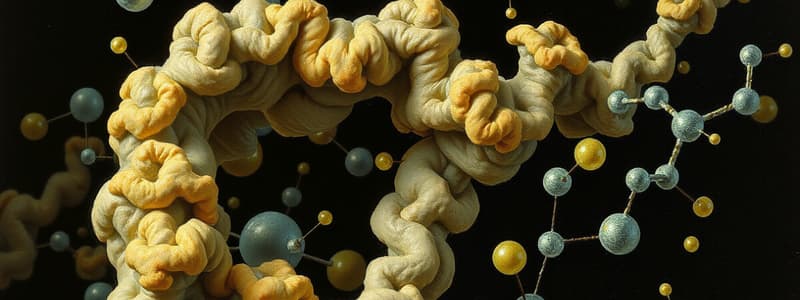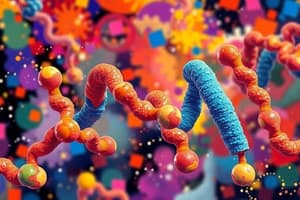Podcast
Questions and Answers
More than half of the amino acids are essential amino acids.
More than half of the amino acids are essential amino acids.
False (B)
Amino acids are joined together by peptide bonds to form proteins.
Amino acids are joined together by peptide bonds to form proteins.
True (A)
Protein means to take last place in Greek.
Protein means to take last place in Greek.
False (B)
The body can synthesize essential amino acids.
The body can synthesize essential amino acids.
Complex proteins are made from simple proteins and non-protein groups.
Complex proteins are made from simple proteins and non-protein groups.
There are 9 essential amino acids that must be supplied by the diet.
There are 9 essential amino acids that must be supplied by the diet.
Derived proteins are formed from primary and secondary degradation products of proteins.
Derived proteins are formed from primary and secondary degradation products of proteins.
Simple proteins can be hydrolyzed to yield carbohydrates.
Simple proteins can be hydrolyzed to yield carbohydrates.
Complete proteins contain all nine essential amino acids and are usually derived from animal sources.
Complete proteins contain all nine essential amino acids and are usually derived from animal sources.
Partially complete proteins contain the required amount of essential amino acids for growth.
Partially complete proteins contain the required amount of essential amino acids for growth.
Incomplete proteins are usually derived from animal sources and lack one or more essential amino acids.
Incomplete proteins are usually derived from animal sources and lack one or more essential amino acids.
Complementary proteins consist of a combination of two or more plant proteins that together provide a balanced diet.
Complementary proteins consist of a combination of two or more plant proteins that together provide a balanced diet.
Proteins in the blood serve only as a source of energy.
Proteins in the blood serve only as a source of energy.
Proteins act as buffers by attracting hydrogen ions and helping to maintain acid-base balance in the body.
Proteins act as buffers by attracting hydrogen ions and helping to maintain acid-base balance in the body.
Hemoglobin is a protein that transports nutrients throughout the body.
Hemoglobin is a protein that transports nutrients throughout the body.
Edema is caused by an excess of fluid accumulation in the tissues due to protein-related issues.
Edema is caused by an excess of fluid accumulation in the tissues due to protein-related issues.
Digestion of proteins begins in the large intestine with the action of bile.
Digestion of proteins begins in the large intestine with the action of bile.
Some proteins can cross the walls of blood vessels under normal conditions.
Some proteins can cross the walls of blood vessels under normal conditions.
A high-protein diet can contribute to heart disease due to high saturated fat content in animal proteins.
A high-protein diet can contribute to heart disease due to high saturated fat content in animal proteins.
Kwashiorkor is primarily caused by excessive protein intake.
Kwashiorkor is primarily caused by excessive protein intake.
The recommended protein intake for adults is 0.8 grams per kilogram of total body weight per day.
The recommended protein intake for adults is 0.8 grams per kilogram of total body weight per day.
Excessive protein intake can lead to increased calcium excretion.
Excessive protein intake can lead to increased calcium excretion.
Marasmus results from a deficiency in both energy and protein.
Marasmus results from a deficiency in both energy and protein.
Protein powders are essential for all athletes to enhance muscle growth and performance.
Protein powders are essential for all athletes to enhance muscle growth and performance.
A diet high in red and processed meats has been correlated with certain types of cancer.
A diet high in red and processed meats has been correlated with certain types of cancer.
The calcium-to-protein ratio for bone protection should be more than 30 to 1.
The calcium-to-protein ratio for bone protection should be more than 30 to 1.
A high protein intake can worsen kidney health in individuals with chronic kidney disease.
A high protein intake can worsen kidney health in individuals with chronic kidney disease.
Legumes and nuts are considered vegetable protein sources that may reduce the risk of heart disease.
Legumes and nuts are considered vegetable protein sources that may reduce the risk of heart disease.
Flashcards are hidden until you start studying
Study Notes
Overview of Protein
- Fundamental component of all living cells: plants, animals, microorganisms.
- Constructed from amino acids and nitrogen, end products of protein digestion.
Amino Acids
- Join together via peptide bonds to form proteins.
- Classified into essential and non-essential amino acids.
- Essential amino acids: 9 that must be obtained through diet as the body cannot synthesize them.
Types of Proteins
-
Simple Proteins
- Yield amino acids upon hydrolysis.
- Examples: Albumins, Globulins, Enzymes.
-
Complex Proteins
- Composed of simple proteins and non-protein groups.
- Examples: Glycoprotein, Phosphoprotein, Lipoprotein, Chromoprotein (e.g., hemoglobin).
-
Derived Proteins
- Formed from the degeneration products of primary and secondary protein structures.
Protein Sources
-
Complete Proteins
- Contain all essential amino acids.
- Typically derived from animal sources: meats, dairy, eggs.
-
Partially Complete Proteins
- Lack required amounts of essential amino acids.
- Example: some fish types lacking methionine.
-
Incomplete Proteins
- Low in one or more essential amino acids.
- Common in plant sources like grains; can be combined to form a complete profile.
Functions of Protein
- Tissue repair and building.
- Energy source.
- Growth stimulants.
- Creation of plasma proteins (e.g., Albumin) to maintain osmotic balance.
- Defense system (antibodies).
Protein in Acid-Base Regulation
- Proteins act as buffers by accepting/releasing hydrogen ions, maintaining blood and body fluid pH (normal range 7.35 - 7.45).
Transport Functions of Proteins
- Carry nutrients in body fluids.
- Hemoglobin transports oxygen; lipoproteins transport lipids.
- Some transport vitamins and act as cellular pumps.
Fluid Balance Regulation
- Proteins mainly reside in cells and plasma; their leakage during illness can cause edema (fluid accumulation).
- Causes of edema include excessive protein loss, inadequate protein synthesis, and dietary deficiency.
Protein Digestion and Absorption
- Proteins are broken down into amino acids and peptides in the stomach and small intestine.
- Absorption occurs in the small intestine with three fates for amino acids: enter circulation for enzymes, convert to other amino acids, or oxidize for energy.
Protein in Food Sources
- Examples include Casein (milk), Albumin (egg white), Gluten (wheat).
Protein Deficiency
- Protein-energy malnutrition (PEM) encompasses conditions from inadequate protein and energy:
- Kwashiorkor: Severe protein deficiency, signs include edema, diminished muscle tone, brittle hair.
- Marasmus: Severe energy and protein deficiency, symptoms include general weakness, growth retardation, and muscle wasting.
Health Implications Related to Protein
- Heart Disease: High animal protein intake linked to increased saturated fats, correlating with heart disease risk.
- Cancer: High red and processed meat intake risks certain cancers; legumes and fish may reduce risk.
- Bone Loss: High protein may increase calcium excretion; adequate calcium-to-protein ratio (20:1) needed for bone health.
- Kidney Disease: Increased kidney workload from high protein may accelerate chronic kidney disease; dietary restriction can slow its progression.
Recommended Protein Intake
- 10-35% of total food energy.
- RDA: 0.8 grams per kg for adults, higher for infants/children.
Protein Powders
- Common in athletic circles, yet do not effectively enhance muscle growth; adequate muscle work is key. Excess protein intake does not further muscle benefits.
Studying That Suits You
Use AI to generate personalized quizzes and flashcards to suit your learning preferences.




